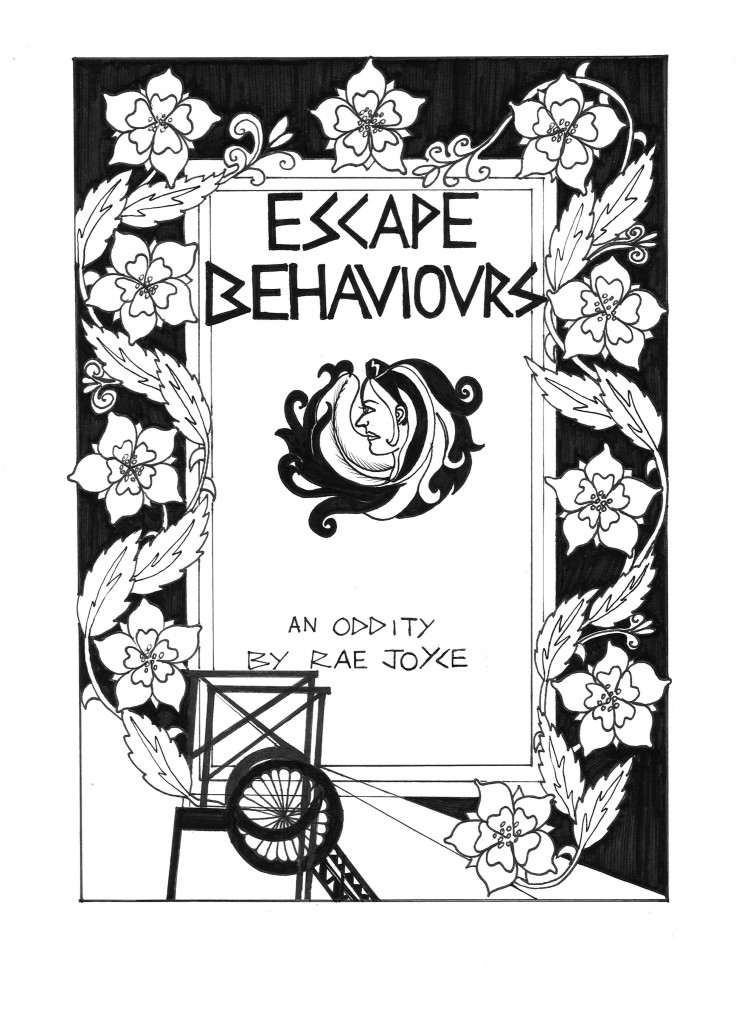 I interviewed author Rae Joyce about her graphic poem Escape Behaviours which will leave you with a lot to think about, like who our heroes are, how they look and what their place should be.
I interviewed author Rae Joyce about her graphic poem Escape Behaviours which will leave you with a lot to think about, like who our heroes are, how they look and what their place should be.
THE MYTHOLOGICAL HERO FROM INSIDE THE KITCHEN
Interview with Rae Joyce, author of Escape Behaviours
Rachel Fenton is an award-winning writer of unique talent. She writes poetry, fiction and (because, she is also a graphic artist) she is making her way into the graphic literature scene, as Rae Joyce.
Her work is characterized by complexity and depth, but also playfulness, joy and what seems like unlimited creative energy. Her writing is fertilized by a unique, honest, straightforward and uncompromising view of the world. She is also an exceptionally warm and generous human being, which makes being inside her mind, while fascinating, also safe and not intimidating.
Escape Behaviours is a work of graphic poetry that you might find different from anything else you’ve ever read. Rachel Fenton is an author whose writing is so creative and exciting to experience that it often challenges the reader: you cannot be absent minded or multitasking while reading, and you cannot just browse her work. The effort, however, is always more than worth it.
I asked her a few questions about her work and, as she always does, she gave this interview a lot of thought and her answers reach far beyond anything I had expected.
________________________________________________________________________

Photo by John McGowan.
Escape Behaviours is a work of graphic poetry. I am a literary snob and I have a hard time relating
to the genre. Why does poetry need graphics? Can you make the case for graphic literature to help
someone like me warm up to it?
RF: First of all, Lori, thank you for inviting me to talk about Escape Behaviours and for having me at your place, it’s smashing to be here.
I’m so glad you asked me this question; I have a hard time relating to the genre too but I’ll expand on this a little more in a moment.
Why does poetry need graphics? Well, the simple answer to that is, it doesn’t. Masses and masses of poetry out there is doing just great without graphics; there’s masses and masses of imagery out there, also, that strikes me as being poetry without words, and that’s doing fine. But there isn’t really much in the way of graphic poetry – Google it, let me know what you come up with. For me, the form was dictated by one very important factor: my target readership — my husband.
Now, back to your first point and I’ll try and wrap it up with your last one. I think it’s difficult to avoid falling into the trap of being a literary snob when so much of what we perceive to be our choice in literary matters is actually the result of our having little choice, which isn’t to say there aren’t myriad books out there to appeal to all tastes – there are – but I think there are two factors which push us to make limited choices as readers.
Firstly, peer pressure; we want to read what others say is great. We are easily swayed by emotive and well written reviews, and we don’t want to be the odd one out. Fair enough. However, the second influential factor (and there are others but I’m simplifying), is capitalism; business and profits is why we choose the books we choose because they are the ones that were chosen to be published because they are the books the vast majority will buy because the vast majority want to read what has been deemed worthy. And another notch on the worthy post is a so called literary book. The literary book is the marketing coup that makes the consumer believe they’re a reader. If you read graphic literature for no other reason than to broaden choice – for the love of reading and expanding your experience (and not profits) it will be worthwhile.
Sorry that’s a whopping response!
Is there a place for women in the graphic literary scene? I was under the impression that the way women are represented in this genre is not very flattering. I bet if many women writers infiltrate it, the situation will change dramatically. What are your thoughts on this? And why is your hero naked throughout Escape Behaviors?
RF: There definitely is a place for women in the graphic literary scene, even if we have to sweep a blumming path through the hordes of superhero lovin’ dudes to make it. Sure, in terms of the genre’s history there’s a definite male trajectory at play but there are women sending the stereotypes off course (typically my brain goes blank here). I think, for starters, the genre is broad, so women such as Marjane Satrapi, (great interview about Persepolis here) whose work I love and seems to have been the inspiration behind Mari Naomi’s graphic memoir graphic novel, have paved the way. Sarah Mensinga, Lee-Yan Marquez, Andrea Offermann, and Sarah Laing are doing it for the comics; the ones who spring immediately to mind, the ones whose work I like for varying reasons, and there’s interesting cross genre stuff being published such as Alex Wilde’s The Constant Losers. Oh, and Posy Simmonds…wow, the more you think, the more women come to mind… I don’t really like graphic novels or comics, to go back to your first question again, but I think I could, given an opportunity, a choice, if the form dares to amble a little farther from the current genre norm.
I hope more women become as prominent as Neil Gaiman, for example, that would be good; to know their names outside of the graphic scene. I’d like to see the form change; I’d like to see more graphic novels getting the critical acclaim afforded to other genres; I’d like more realistic and non-sexist depictions of women – then I’d read more comics and graphic novels – so, women who represent real women would definitely figure into this. And domestic life; I’m infuriated by authors who say they are sick of domestic fiction then go on to lambaste women who perpetuate the notion of women at home. To these people I say, you are lucky, that you do not have this kitchen orientated life, but for the vast majority of women – the women I identify with – the sink is the norm. And yeah, I’d love to liberate women from domesticity but that won’t happen if we only present the world with fiction where women are not recognisable to the majority. And, it comes back to choice – women so often do not have the choice to leave their domestic orientated lives yet the myth we do is all around us. Give me a woman I can relate to and show me how she changes her circumstances.
My hero is naked for several reasons. As a work of poetry, and confessional, self-referential, (memoir?) poetry at that, I was already presenting myself naked metaphorically. So, the hero’s nakedness is, in the first instance, a metaphor for my baring my-self. But beyond this it’s an expression of freedom, of choice and right.
I’ve long been interested in representations of women and the body in art, and particularly sculpture. I’ve read extensively about Camille Claudel, Rodin’s contemporary, about how women were not allowed to draw naked subjects in life class (men were), and how her work, for all its skill and artistry, was deemed too sexual if it revealed too much of the human form in realistic detail. Conversely, the more explicit of Rodin’s sculptures were not criticised in this way. This prejudice still exists. Escape Behaviours is as much about taking authorship of my-self as it is a nod to the body in art. The hero’s nakedness is also an act of defiance against modesty.
I think modesty has become the control word for women. All women may not have spouses or partners to give them permissions because they have other people (too often, other women) to moderate them. Society says, you can sell your product on a naked woman’s body, you can make her a celebrity, a music star, you can bombard her with thousands of images and messages each day about what a beautiful woman is and how she should look, you can have polls on who is the most beautiful woman, but a woman cannot call herself beautiful, cannot present herself in her naked form by free will, cannot tell YOU what she is without waiting to be asked or told as this is deemed, if not immodest, then arrogant; arrogance seems to be the opposite term, the negative counter to modesty for women. If a woman presents confidence, she is arrogant, if a woman puts herself forward, suggests she is qualified for a position of high status without waiting to be told she has that worth, she is arrogant.
What is the genesis of Escape Behaviors? Can you tell us a few words about what made you write this story and why you chose this form for it?
RF: Escape Behaviours started out as a series of provocations to get my husband’s attention – no mean feat when your husband a) doesn’t like poetry and b) doesn’t read anything you write. But he will read comic strips and graphic novels (of which my daughter is a huge fan), so I had over a hundred poems addressed to my husband in some way, either about us or the great white elephant in our lives, his stutter, and I wanted him to read them. Putting the words into pictures achieved that.
As the project progressed, I realised the images brought extra elements to the poems I hadn’t envisaged, and at times I left out the words and let the images do the communicating. I saw a relationship between the image and what the poem was trying to express that I hadn’t noticed before. It excited me.
I love the ending of Escape Behaviors: “In every home, forgotten, every woman’s a hero, muse, and goddess.” It’s beautiful and sad at the same time. What hope do you see for a forgotten hero?
RF: Ah, see, that’s a tricky question. Can one be an optimistic nihilist? And, of course, there’s that rotten forgotten; you can’t hold hope for what you don’t remember, can you? And if she’s not really forgotten, well, then you’ve called the whole thing into question….I think society likes to raise select individuals up and make heroes of them but I think this is perception. By turning the page around you could view this same act as society squashing the masses down a little more to reveal these heroes. The hope, then, is for perceptions to see all women as raised and all society equal. I think when a phrase like the one you’ve quoted has no impact, no power at all, when the need to stand out at all is gone, that’ll be the time such a hero can be forgotten.
I think that your work has a very strong feminine imprint. Many women writers of today and yesterday have tried to hide their gender under pseudonyms and have considered a great praise to be told that they write just like a man. Escape Behaviors does not disguise its gender in any way. How do you feel about that?
RF: I don’t think there’s any chance of equality while ever we assert a myth that men have greater intellectual worth. Escape Behaviours is definitely a celebration of womanhood – however bittersweet my personal experience may have been – and I’d like to think this comes across. I consciously used a contraction of my own name to emphasise the point, Rae Joyce, which, if you say it fast comes out rejoice.
Do you want to add anything else that you feel is important for the readers to know about your work?
RF: I’m not trying to be didactic. I think my work presents a picture of a formidable woman; this wasn’t and isn’t always so. But if we all, each of us, support one other woman, even if that’s by not criticizing where before maybe we’d utter “silly woman”, however harmlessly it was meant, then, I think, good things can happen, and you don’t need a cape, pert tits or superhero abs!
________________________________________________________________________
Rachel Fenton is a writer based in New Zealand. Her poetry has appeared in Horizon Review, Blackmail Press, Otoliths, Brief and more, and it was longlisted for the Kathleen Grattan Award. Her fiction was longlisted for the Sean O’ Faolain Short Story Prize and shortlisted for the Fish One Page Prize, Binnacle Ultra Short Competition. This year, her short graphic fiction “Alchemy Hour” won the AUT New Zealand Creative Writing Competition. You can find out more about the author on her Web page, Snow Like Thought.
2012 Interview by Lori Tiron-Pandit.
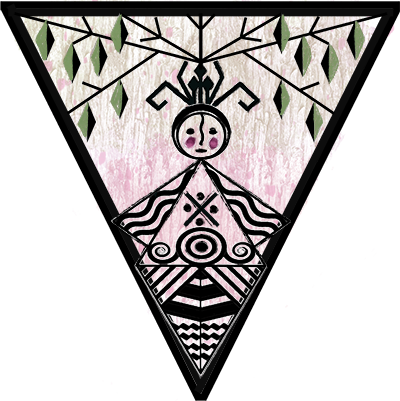
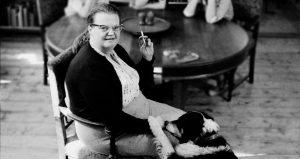
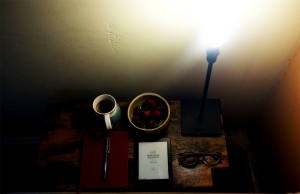
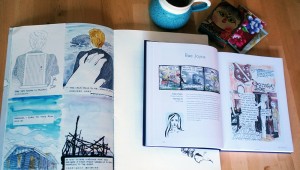
Good to read such a thorough piece about Escape Behaviours. It is a stunning piece of work.
I know. It is an exceptional work.
Thanks for reading the interview.
Thanks so much for reading, Rachel, and for saying such lovely things about it! 🙂
Hi Lori,
Its been a very long time since i’ve been here….in fact first time visit to your new location,
what and where i like to discover you is in your own wonderful personal poems and in the magnificient translations you do of the rich culture where you come from.
i left you a comment on your Kanheri caves posting!
i hope you ‘ll post other photos of the place. i visited the Elephanta caves in Mumbai….unfortunately the Muslim invasions did’nt spare much!
have a nice day!
hugs
col
Hi, Col. So nice to hear from you. Isn’t it interesting that we were in India at the same time? I enjoyed it a lot. I am going to check your blog and see if you posted anything from your travels. Thank you as always for your too kind words about my work!
The idea of combining poetry & graphic art is an interesting one & made me think of the the collaboration between W.G. Sebald & Jan Peter Tripp altho not a graphic book as perceived now but the photorealism of Tripp’s art in dialogue with Sebald’s poetry creates a new point of reference and a new dialogue with the reader.
The meeting ground of different art forms is always a fascinating place, isn’t it? I need to check the collaboration you mention, but poetry and graphic arts indeed seem like suitable partners with a lot to bring to the relationship.
I think the Sebald/Tripp effect is what’s at play with “Alchemy Hour” from the way you describe it, (but I haven’t seen the work; will have to search it now. Thanks) where the the art isn’t “about” the poetry but it communicates another, hidden, aspect of it – and vice versa – so that the two works become one.
With Escape Behaviours I was definitely visually representing not only the action of the poems – some literal representation – but I was also trying to find and play with the point where the action on the page goes far beyond the confines of the words, where something new is expressed.
And I absolutely agree with Lori – graphic art has a lot to bring to poetry and I’m excited about pushing a new form – cannot describe how exciting that feels!
Thanks for reading.
Thanks for that, Annie. I hope you enjoy reading it.
Kindest,
Rae
Hi Lori,
I enjoyed reading your in depth interview and Rachel’s responses. Just glancing so far, I love the creativity, concept and composition in Escape Behaviours; and I’m looking forward to reading it.
Thank you, Annie. I know you appreciate illustration and graphic art, and being a poet yourself, you will enjoy Escape Behaviours for sure.